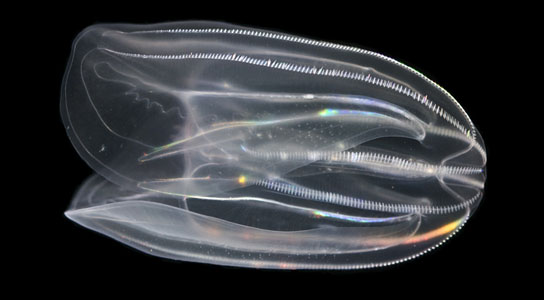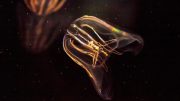
Comb jellies derive their name from the eight comb-like structures, called cilia, that propel these animals through the water. Credit: Bill Browne/University of Miami
Comb jellies, known as the phylum Ctenophora, live in marine waters worldwide. They have a distinctive feature in their groups of cilia, which they use to swim. They are the largest animals that use cilia as a means to swim. Adults range from a few millimeters in length to 1.5 meters.
Their bodies consist of a mass of jelly, having one layer of cells on the outside and another layer lining the inside. Ctenophores have these layers two cells deep. They have a decentralized nerve net, rather than a more centralized brain, and rely on water flow through the body cavity for digestion and respiration.
These organisms are quite sophisticated in how they use light and researchers studying the genome of ctenophores have discovered that the creatures have 10 proteins to generate light. The scientists published their findings in the journal BMC Biology.
The animals will flash blue-green lights at predators, possibly to startle them. They use other proteins called opsins that detect light, even though comb jellies lack eyes. The genome is the first to be sequenced from a bioluminescent animal and it’s not clear what ctenophores use the opsins for.
Since ctenophores appear to sit at the base of the animal tree of life, the findings suggest that light-generating and sensing proteins evolved at the same time as multicellularity. These proteins may have given rise to the light-sensing molecules seen in animals today and this research could lead to new insights into the origin of eyes and therapies for treating sight disorders.
Reference: “Genomic organization, evolution, and expression of photoprotein and opsin genes in Mnemiopsis leidyi: a new view of ctenophore photocytes” by Christine E Schnitzler, Kevin Pang, Meghan L Powers, Adam M Reitzel, Joseph F Ryan, David Simmons, Takashi Tada, Morgan Park, Jyoti Gupta, Shelise Y Brooks, Robert W Blakesley, Shozo Yokoyama, Steven HD Haddock, Mark Q Martindale and Andreas D Baxevanis, 21 December 2012, BMC Biology.
DOI: 10.1186/1741-7007-10-107









Be the first to comment on "Comb Jellies Have Proteins to Generate & Sense Light"